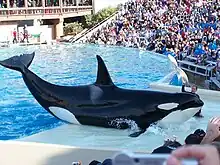 Corky II on the slide out during the Shamu Show at SeaWorld San Diego. | |
| Species | Orca (Orcinus orca) |
|---|---|
| Sex | Female |
| Born | est. 1965 (age 58–59) |
| Years active | 1969–present |
| Known for | Oldest captive orca as of 2023 |
| Parent(s) | Stripe (mother) |
| Mate(s) | Orky II |
| Offspring | Spooky (son) Kiva (daughter) (none survived to adulthood) |
| Weight | 8,000 lb (3,600 kg)[1] |
| Named after | Orca named Corky (died 1970) |
Corky II (born c. 1965), often referred to as just Corky, is a female captive orca from the A5 Pod of northern resident orcas. At approximately the age of four, Corky was captured from Pender Harbour off the coast of British Columbia on December 11, 1969.[2] She has lived at SeaWorld San Diego in San Diego, California since 1987. As of 2023, she is the oldest and longest kept captive orca.[3] SeaWorld San Diego celebrates her birthday on 2 January every year.
Early life
Corky was born in 1965. Her mother, designated A23, nicknamed "Stripe", died in 2000. Corky, along with a young unnamed male and a young female later named Patches, were sold to Marineland of the Pacific, in Palos Verdes, California. As of 2022, Corky is the only surviving captured orca from her family group. She is designated A16.[4]
Captivity
Corky II received her name after the park's original orca, Corky I, died in December 1970. Corky was kept with a male named Orky II, also caught in Pender Harbour the year before her own capture. The pair remained together at the park for the next seventeen years and mated.[5] Corky became the first orca to produce offspring in captivity and on February 28, 1977, she gave birth to the first captive calf. However, the infant male failed to nurse and died of pneumonia after just eleven days. Corky and Orky had six more calves but none survived, the oldest, named Kiva, lived just forty-six days.[6] Corky and Orky also appeared in the 1977 film Tentacles.[7]
In 1987, Corky was sold to SeaWorld and was moved with Orky to the park in San Diego, California. There, she mated with Icelandic male orcas, and both calves died within days of their birth.[8] Orky later bred with other females at SeaWorld and sired two female calves, Orkid and Kayla, who died in 2019. Corky never became pregnant again. In 1988, Orky died three days after the birth of his first daughter. He was the oldest and largest captive orca at the time of his death.[9]
As of 2023, Corky remains at SeaWorld San Diego and lives with seven other orcas.[10]
Incident
In 1989 the dominant female orca, Kandu V, charged at Corky but ruptured an artery in her own jaw during the fight. After a 45-minute hemorrhage, Kandu V died. Her eleven month old daughter, Orkid, was placed with Corky, who acted as a surrogate mother.[11][12][13]
Controversy
Corky is the subject of various campaigns by animal rights activists demanding her retirement and release.[14] In 2017, a Canadian orca research organization created a banner from more than 17,000 pieces of artwork that stretched 1.5 miles as a means to promote her freedom.[15] A proposed 40 acre sea sanctuary located off Hanson Island in British Columbia has been proposed for her relocation, but SeaWorld remains resistant, arguing Corky would not survive.[16] Support for her release surged after Lolita died before her release, including people writing letters to SeaWorld.[17][18]
See also
Further reading
- Ford, John K.B.; Ellis, Graeme M.; & Balcomb, Kenneth C. (2000). Killer Whales (2nd ed.). UBC Press. ISBN 0-7748-0800-4.
- Hoyt, Erich. (1990). Orca: The Whale Called Killer (3rd ed.). London: Robert Hale Limited. ISBN 0-920656-25-0.
- Morton, Alexandra. (2002). Listening to Whales: What the Orcas Have Taught Us New York: Ballantine Publishing Group. ISBN 0-345-43794-2.
- Patryla, Jim. (2005). A Photographic Journey Back To Marineland of the Pacific Lulu Publishing. ISBN 978-1-4116-7130-0.
References
- ↑ "Performing Whale Dies in Collision With Another". The New York Times. 23 August 1989. Retrieved 28 April 2021.
- ↑ "Corky's Story". Hal Sato. Archived from the original on March 7, 2016. Retrieved January 29, 2016.
- ↑ Palmer, Mark J (21 May 2020). "MEET CORKY, THE LONGEST-HELD ORCA IN CAPTIVITY". savedolphins.eii.org. Retrieved 28 April 2021.
- ↑ "Corky's Calves". orcaaware.org. British Divers Marine Life Rescue.
- ↑ Farhoud, Nada (1 May 2020). "Fight to reunite Orca with family after being held captive in tank for 50 years". mirror.co.uk. Daily Mirror. Retrieved 28 April 2021.
- ↑ "Corky". dolphinspirit.org. Retrieved 28 April 2021.
- ↑ "Photo from the movie "Tentacles" provided by CoolAssCinema.com and Kimmy Vengeance". inherentlywild.co.uk. Retrieved 10 May 2021.
- ↑ "Corky's Calves". orcaaware.org. British Divers Marine Life Rescue.
- ↑ Roach Monroe, Linda (27 September 1988). "Orky, Oldest Killer Whale in Captivity, Dies". Los Angeles Times. Retrieved 28 April 2021.
- ↑ "Killer Whale Education and Conservation". seaworld.com. SeaWorld. Retrieved 28 April 2021.
- ↑ "Performing Whale Dies in Collision With Another". The New York Times. New York Times. 23 August 1989. Retrieved 6 May 2018.
- ↑ REZA, H.G.; JOHNSON, GREG (23 August 1989). "Killer Whale Bled to Death After Breaking Jaw in Fight". Los Angeles Times. Retrieved 6 May 2018.
- ↑ REZA, H.G. (22 August 1989). "Whales Collide, 1 Is Fatally Injured in Sea World Tank". Los Angeles Times. Retrieved 6 May 2018.
- ↑ "Free Corky Campaign". orcalab.org. Retrieved 28 April 2021.
- ↑ "SeaWorld Won't Miss This 1.5-Mile-Long 'Free Corky' Banner". seaworldofhurt.com. 13 May 2017. Retrieved 28 April 2021.
- ↑ "Returning 'Corky,' a wild orca, to her birthplace after 50 years in captivity". cbc.ca. Canadian Broadcasting Corporation. Retrieved 28 April 2021.
- ↑ https://www.local10.com/news/local/2023/08/20/activists-hol
- ↑ Gibson, Caitlin (December 5, 2023). "The call of Tokitae". The Washington Post. Archived from the original on December 5, 2023. Retrieved December 10, 2023.